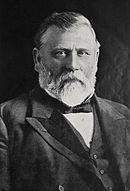4 (general) & 19 December (Māori) 1896 1899 → 1893 1894 39 26 Date 4 December 1896 | Turnout 76.1% 51 seats 13 seats 12 13 | |
 | ||
Winner Richard Seddon | ||
The New Zealand general election of 1896 was held on Wednesday, 4 December in the general electorates, and on Thursday, 19 December in the Māori electorates to elect a total of 74 MPs to the 13th session of the New Zealand Parliament. A total number of 337,024 (76.1%) voters turned out to vote.
Contents
1896 was the year the limit of £200 was placed on each candidate's campaign spending.
Background
The Liberal government campaigned on a platform that the election was between the people and the "selfish few". The economy stagnated, raising unemployment, which caused support for the Liberals to fall in the cities and they lost many seats, though not enough to be removed from office by the Conservatives. In rural areas, the swing in support was not as large due to the public works and land settlement programmes helping to support the regions. In June 1896 Seddon had replaced Joseph Ward as Finance Minister whilst the latter had resigned after being declared temporarily bankrupt. As such Seddon himself took on the workload of the treasury making him more susceptible to opposition attacks over the economy. He proved to be a cautious financier, budgeting for surpluses while maintaining the spirit of self reliance his predecessor John Ballance had advocated.
Party totals
The following table gives party strengths and vote distribution according to Wilson (1985), who records Maori representatives as Independents prior to the 1905 election.
Votes summary
The table below shows the results of the 1896 general election:
Key
Liberal Conservative Independent Liberal Liberal-Labour Independent
Table footnotes:
The election of Thomas Wilford for the electorate of Suburbs of Wellington was declared void by an election petition on the grounds of corrupt and illegal practices. Charles Wilson was elected MP for that electorate following a by-election on 23 April 1897.
